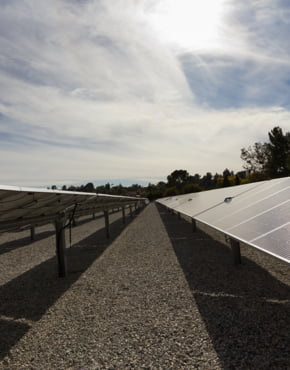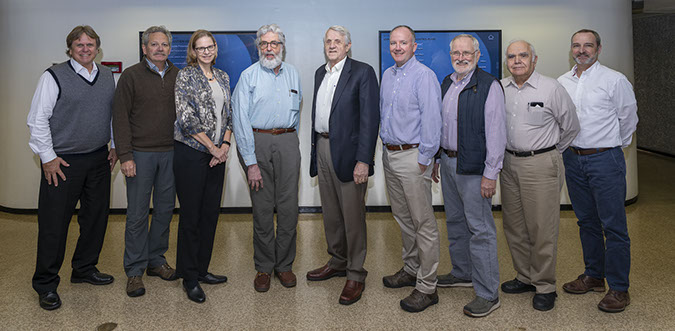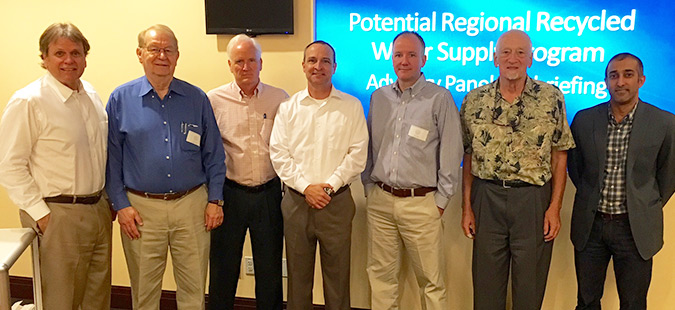Regional Recycled Water Advanced Purification Center: Phase I
Find a Document


In our climate, water is too precious to use just once. That’s why Metropolitan is partnering with the Los Angeles County Sanitation Districts on Pure Water Southern California, a regional water recycling program that would purify and reuse cleaned wastewater that currently flows into the ocean. At full scale, Pure Water Southern California would produce 150 million gallons of purified water each day.
By delivering a new, climate-resilient supply of locally available water, Pure Water Southern California would benefit the 19 million people living within Metropolitan’s service area. It also would become one of the world’s largest water recycling programs.
About the
Grace F. Napolitano
Pure Water
Southern California
Innovation Center
Think of it as a living laboratory. The Grace F. Napolitano Pure Water Southern California Innovation Center features a state-of-the-art demonstration plant, which began operation in October 2019. One of the main purposes of the demonstration plant, which produces 500,000 gallons of purified water per day, is to facilitate regulatory approval of the innovative purification technology being proposed for the full-scale program. The demonstration plant also is generating information that will enable optimal design of the program’s advanced water purification facility.
Here, scientists and engineers test each stage of the purification process to make certain that the purified water meets or exceeds California’s water quality standards, which are among the highest in the world. This means the purified water is safe to use for the replenishment of local groundwater basins and eventually for drinking.
Once the program is fully operational, purified water would be transported up to 60 miles through a network of pipelines to groundwater basins, industrial facilities and potentially to two of Metropolitan’s water treatment plants.
A Look Inside How It Works
The demonstration plant uses an innovative three-step purification process. The first step involves membrane bioreactors; the second step is reverse osmosis; and the third step is ultraviolet disinfection and advanced oxidation.
What makes our purification process innovative is how and when MBRs are used. They have been used in the wastewater industry for decades but are relatively new for purifying water for reuse. Initial pilot studies by Metropolitan and the Sanitation Districts found that MBRs may be a cost-effective first step in the purification process for water reuse. Once approved by state regulators using data from our demonstration plant, this innovative technology could be applied across California and even globally to increase the efficiency of other water recycling programs.


The Purification Process
Membrane Bioreactors
Membrane bioreactors use biological processes and membrane filters to clean water.
Air is added to biological process tanks to create an environment where helpful microorganisms can thrive. These microorganisms effectively remove organic material and nitrogen compounds, such as ammonia and nitrate, from the water.
The water also flows through tanks where thousands of straw-shaped membranes with tiny openings filter and remove microscopic materials, including microorganisms and other particles. Many of the microorganisms and particles removed through this process are smaller than 1/100 of a grain of sand.
Reverse Osmosis
Reverse osmosis is often considered the core step in the water purification process, as it effectively eliminates more than 99% of all impurities. Water leaving the MBRs is pressurized through a series of pumps and pushed through tightly wound membranes. RO membranes selectively allow water molecules to pass through, while blocking the passage of microscopic materials such as bacteria, pharmaceuticals and salts.
Reverse osmosis is commonly used to remove salt in desalination projects, as well as in the commercial production of bottled water.
Ultraviolet Light/Advanced Oxidation
Ultraviolet light is a powerful disinfectant used to inactivate viruses in water. When UV light is combined with a strong oxidant such as hydrogen peroxide or sodium hypochlorite, extremely reactive molecules are created. These molecules effectively remove any trace chemical compounds that may persist through the first two phases of water purification. The combination of the UV light and a strong oxidant is referred to as the Advanced Oxidation Process. This is a final refining step that ensures the purified water is safe and meets or exceeds all water quality standards.
Demonstration Plant Tours
Take a tour of the Grace F. Napolitano Pure Water Southern California Innovation Center to learn more about the demonstration plant, its innovative purification process and the importance of water recycling to Southern California’s future water supply. In-person tours are available in English and Spanish. Virtual tour options are also available.



“The best science tells us that we need to act now to adapt to California’s water future.”
Gov. Gavin Newsom


Over a Decade
in the Making
Since the early 1960s, the Los Angeles County Sanitation Districts have operated water recycling plants that clean and reuse wastewater to safely replenish groundwater basins, our natural underground water reservoirs. Since the early 1980s, Metropolitan has supported the development of new local supply projects by its member agencies, including recycling projects. Until now, Metropolitan has never had a water recycling project of its own, but through this creative partnership, the two agencies are collaborating on what could set a global precedent as one of the largest water recycling programs.
This large-scale program requires many collaborators, and Pure Water Southern California has many partners, including groundwater basin managers, other Metropolitan member agencies and even water agencies in Arizona and Nevada. The shared goal is to create a sustainable water future that balances local water resources with imported supplies from the Colorado River and the State Water Project, which are experiencing increased stress and long-term uncertainty in the midst of a changing climate.
Innovation at Work
Pure Water Southern California is novel in its proposed purification process and in its regional scale, but the concept of recycling water is not new and has been widely recognized as proven technology. Several countries worldwide and many communities across Southern California, including some in Los Angeles, Orange and San Bernardino counties, use recycled water to replenish groundwater basins that eventually supply water for drinking and other applications.
Click on the 
The City of San Diego is constructing a new water recycling plant and associated facilities to produce 30 million gallons of purified water daily. This is the first phase in its multi-year Pure Water Program that will provide one-third of the City’s water supply by 2035.
The Edward C. Little Water Recycling Facility purifies water from the City of Los Angeles' Hyperion Wastewater Treatment Plant and produces water for irrigation water, industrial use, and adding to groundwater to prevent seawater intrusion.
The Groundwater Replenishment System is the world's largest advanced water purification system. The system produces 100 million gallons of purified water daily to help refill groundwater basins. It is currently undergoing an expansion to 130 million gallons daily.
The Albert Robles Center purifies and recycles approximately 14.8 million gallons of water daily, which is used for groundwater replenishment. The Center is a multipurpose and multi-benefit site which includes an Advanced Water Treatment Facility, a fully digital Learning Center, and a water-efficient Demonstration Garden.
Pure Water Oceanside is an advanced water purification program that purifies recycled water to create a new, local source of drinking water. Between 3 to 5 million gallons of drinking water is created each day, enough to provide 32% of the City of Oceanside’s water supply.
Recycled water makes up more than one-third of Eastern Municipal Water District’s water supply portfolio. Recycled water is used for agriculture, irrigation and industrial use. EMWD is also planning to produce purified recycled water for groundwater replenishment through its Purified Water Replenishment program.
The City of Oxnard’s Advanced Water Purification Facility produces recycled water for irrigation of parks, medians, golf courses and athletic fields; watering of agriculture crops; and process water for local industries. The City plans to expand its facility and use recycled water for groundwater replenishment.
IEUA receives and cleans more than 50 million gallons per day of wastewater, which is then used for agriculture, municipal irrigation, industrial uses, and for groundwater replenishment. IEUA is also planning to provide additional purified recycled water for groundwater replenishment by 2028.
The East County Advanced Water Purification Program will create a new drinking water supply utilizing state-of-the-art technology to recycle the region’s wastewater. The project is under construction and scheduled to be online in 2025.
The Los Angeles County Sanitation Districts began replenishing groundwater with recycled water in 1962 at their Whittier Narrows Water Reclamation Plant. Recycling has since expanded to 10 treatment plants and they have recycled over 1 trillion gallons.
Pure Water Southern California’s Environmental Review Process
The next major step in the Pure Water Southern California program is completing its environmental review. The environmental review process allows Metropolitan and the Los Angeles County Sanitation Districts to explore and understand the project’s potential impacts to communities and the environment.
Steps in the Environmental Review Process
During the environmental review process Metropolitan and the Sanitation Districts will prepare an Environmental Impact Report (EIR). Development of the EIR includes three phases and public involvement opportunities.
1. Scoping Phase: Complete
The first part of the environmental review process is the scoping phase, which is initiated by a Notice of Preparation that tells public agencies and interested parties that an Environmental Impact Report will be prepared. Feedback is encouraged to help identify environmental issues and raise questions and concerns for further study in the EIR. Project alternatives, community impacts and mitigation measures also are considered.
We completed the scoping phase of the environmental review process in November 2022.
2. Draft EIR Release: 2025
The Draft EIR will be available for public review to allow community members, interested parties and agencies the opportunity to provide feedback and comments. Metropolitan staff will review comments, prepare responses, and revise the EIR as needed.
3. Final EIR Certification: 2025-2026
The Metropolitan Board of Directors will review and consider certification of the Final EIR during a board meeting, which will be open to the public.
Resources
English
Pure Water Southern California Program Brochure
A Look Inside: The Grace F. Napolitano Pure Water Southern California Innovation Center
Benefits of the Pure Water Southern California Program
Spanish
Folleto del programa Pure Water Southern California
Un Vistazo Al Interior: El Centro de Innovación Grace F. Napolitano Pure Water Southern California
Environmental Review Documents and Resources
Read the Notice of Preparation here.
Watch a recording from a past virtual community meeting:
Meeting in English
Meeting in Spanish
Watch a video to learn how to participate.
English version:
Watch the Scoping Participation Video
Spanish version:
Vea el vídeo sobre cómo participar durante la fase de alcance
Check out our guide for submitting scoping comments here.
Presentations
Pure Water Southern California Partnership Development Update - Presentation (November 2024)
Pure Water Southern California Quarterly Update - Presentation (September 2024)
Update on Outreach for Pure Water Southern California - Presentation (August 2024)
Update on Public Opinion Research for Pure Water Southern California - Presentation (August 2024)
Pure Water Southern California Quarterly Update - Presentation (June 2024)
Update on Pure Water Southern California Partner Agreements - Presentation (June 2024)
Review of Cost Recovery Alternative 6 - Presentation (March 2024)
Pure Water Southern California Quarterly Update - Presentation (March 2024)
Pure Water Southern California Demand Projections - Presentation (March 2024)
Review of Cost Recovery Alternative 6 - Presentation (March 2024)
Assessment of Reuse Alternatives for Pure Water Southern California - Presentation (January 2024)
MWD Board Item 3-B Staff Presentation (November 2023)
MWD Board Item 6-A Staff Presentation (October 2023)
MWD Board Item 3-A Staff Presentation (June 2023)
MWD Board Item 3-B Staff Presentation (June 2023)
MWD Board Item 3-B Staff Presentation (March 2023)
MWD Board Item 7-3 Staff Presentation (March 2023)
MWD Board Item 7-5 Staff Presentation (January 2023)
Awards & Recognitions
Technical Resources
Agreements
Letters of Intent
Advisory Panels
Independent Science Advisory Panel: Demonstration Project
The Pure Water Southern California Demonstration Plant is a facility that uses a unique application of membrane bioreactors in the advanced water treatment process. This demonstration facility will be used to evaluate the performance of the membrane bioreactors with reverse osmosis and an ultraviolet/advanced oxidation process. The project will also develop design criteria for a potential full-scale facility, clarify costs for advanced treatment, and ultimately obtain regulatory permits for a full-scale program.
An independent science advisory panel has been selected to provide an objective review of technical, scientific, regulatory, and public health aspects of the Advanced Purification Center. To ensure objectivity, the National Water Research Institute NWRI, a nonprofit organization with extensive experience in the water reuse industry, selected the panel and will manage its activities. The panelists represent industry and academic experts in drinking water treatment, wastewater treatment, advanced water treatment, toxicology, chemistry, microbiology, hydrogeology, pipeline corrosion, and drinking water and recycled water regulations and permitting. The panelists are listed below with their areas of expertise.

Pure Water Southern California Advisory Panel, pictured from left: Ed Means (Panel Facilitator), Adam Olivieri, Nancy Love, Charles Haas, Vernon Snoeyink, Paul Westerhoff, Richard Bull (previous member), Joe Cotruvo, Thomas Harder, Paul Anderson (not pictured).
Panelists:
Paul Anderson, Ph.D.: Adjunct Professor, Center for Energy and Environmental Studies, Geography Department, Boston University. Dr. Anderson has been involved in toxicological research for more than 25 years. His expertise is toxicology.
Joe Cotruvo, Ph.D.: President of Joseph Cotruvo and Associates, LLC. Dr. Cotruvo has more than 45 years of experience conducting research and writing policy related to drinking water quality. His expertise is chemistry.
Charles Haas, Ph.D.: Betz Chair, Professor of Environmental Engineering & Head, Department of Civil, Architectural and Environmental Engineering, Drexel University. Dr. Haas has more than 45 years of experience conducting research. His expertise is microbiology.
Thomas Harder: Principal, Thomas Harder and Company Groundwater Consulting. Mr. Harder has more than 22 years of professional groundwater consulting experience. His expertise is hydrogeology.
Nancy Love, Ph. D.: Borchardt and Glysson Collegiate Professor, Department of Civil and Environmental Engineering, University of Michigan. Her research evaluates the fate and removal of pathogens and contaminants of emerging concern in water with relevance to public health and the environment and advances technologies that recover useful resources from water.
Adam Olivieri, Ph. D.: Principal/Founder, EOA Inc. Dr. Olivieri has over 30 years of experience in leading technical and regulatory projects associated with wastewater, water recycling and reuse, and others. His expertise is water regulations and permitting.
Vernon Snoeyink, Ph. D.: Professor Emeritus at the University of Illinois. Dr. Snoeyink’s research career has focused on aquatic chemistry and corrosion control, focusing on drinking water distribution systems. His expertise is pipeline corrosion.
Paul Westerhoff, Ph.D.: Regents Professor, School of Sustainable Engineering and The Built Environment, Arizona State University. Dr. Westerhoff has taught at Arizona State University since 1995. His expertise is drinking water treatment and advanced water treatment.
The independent science advisory panel will participate throughout the testing period for the demonstration project and until report(s) are submitted to regulators for approval of the purification process.
The independent science advisory panel is the second panel for the Regional Recycled Water Program. Initially, an advisory panel was created to provide input on the feasibility of the program.
Advisory Panel: Feasibility Study
Metropolitan and Los Angeles County Sanitation Districts are working collaboratively to develop a potential regional recycled water supply program that would purify and reuse water for recharge of groundwater basins in Southern California. An advisory panel of key subject matter experts was established to provide independent review and critical input on the scope and direction of the program during its demonstration project phase. In this initial effort, the panel provided input into the development of the program's feasibility and financial assessments, as well as the design of the demonstration plant.

Pure Water Southern California Advisory Panel, pictured, from left: Ed Means, Joe Reichenberger, Richard Atwater, Thomas Harder, Paul Westerhoff, David Jenkins, Shivaji Deshmukh, Margie Nellor (not pictured).
Panelists:
Margie Nellor, Co-Chair: Expert on recycled water reuse programs, pretreatment and related regulatory issues.
Richard Atwater, Co-Chair: Expert in recycled water programs and past Executive Director of Southern California Water Committee.
Shivaji Deshmukh: West Basin Municipal Water District, Assistant GM with recycled water engineering and operational experience with Advanced Water Treatment facilities at both the West Basin Water Recycling Facility and the Groundwater Replenishment System in Orange County.
Thomas Harder: Hydrogeologist with expertise on Southern California's groundwater basins.
David Jenkins: Professor Emeritus of Civil and Environmental Engineering at UC Berkeley, with expertise on biological wastewater treatment processes, and water and wastewater chemistry (passed away March 2021).
Ed Means: Internationally recognized water quality and water resources management expert, with over 35 years experience, numerous peer-reviewed publications, and contributor or author of several books.
Joe Reichenberger: Professor at Loyola Marymount University, Professional Engineer and Board Certified Environmental Engineer, with over 50 years experience in water, wastewater and recycled water systems and treatment.
Paul Westerhoff: Professor at Arizona State University with expertise in advanced treatment processes.
The panel met periodically to review and discuss selected topics presented by project staff. These reviews provided input on:
The work of the program advisory panel is now complete. A new independent science advisory panel has been formed to provide input on the demonstration project.
Approach for Alternative Treatment Technology Acceptance
Contact